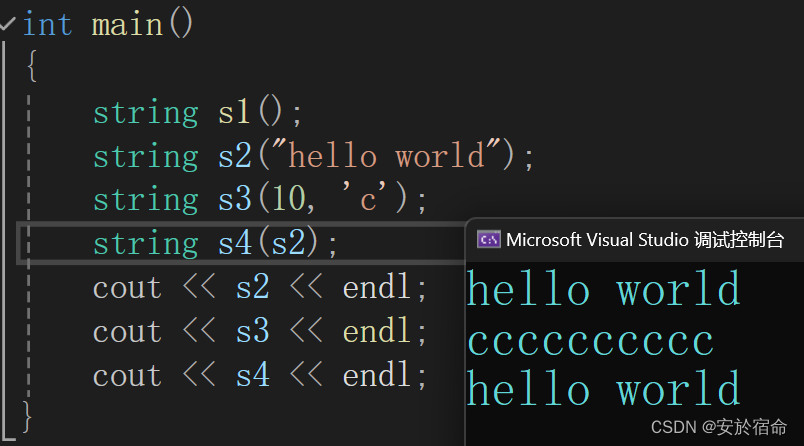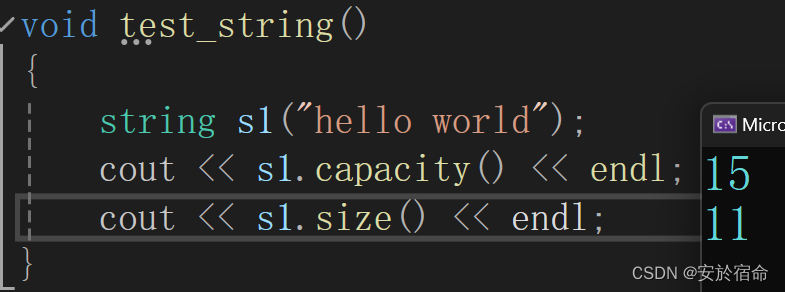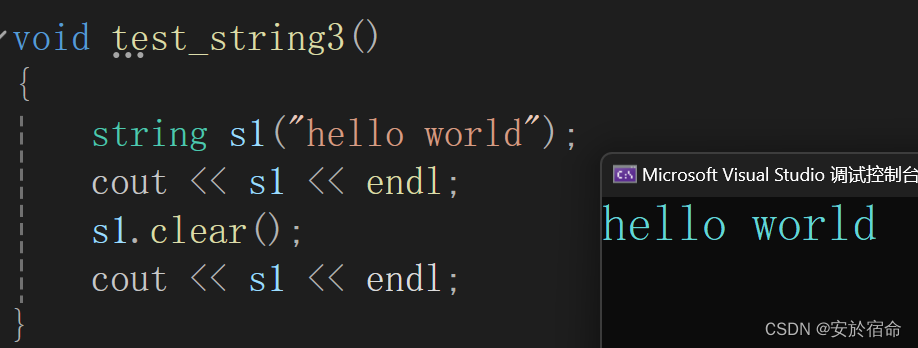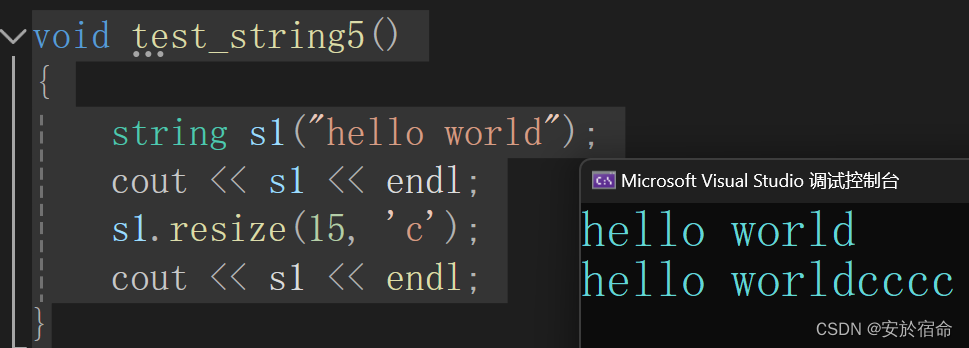文章目录
string类string类的接口string的常见构造string类对象的容量操作string类的遍历及访问操作string类对象的修改操作string类的非成员函数 总结

string类
C++中的string类是一个非常重要的字符串处理工具,它提供了一种方便且灵活的方式来处理字符串。它位于标准命名空间std下,因此通常需要使用using namespace std;语句或者前缀std::来引用。
在string类中有很多接口,学习这些接口对后面学vector、list还有stack和Queue有帮助。
string类的接口
string的常见构造
| 函数名称 | 功能说明 |
|---|---|
| string() | 构造空的字符串 |
| string(const char* s) | 用一个C-string来构造一个string类 |
| string(size_t n, char c) | string类包含n个c字符 |
| string(const string&s) | 拷贝构造函数 |
举例:
int main(){string s1();string s2("hello world");string s3(10, 'c');string s4(s2);}
string类对象的容量操作
| 函数名称 | 函数功能 |
|---|---|
| size | 返回字符串的有效长度 |
| length | 返回字符串的有效长度 |
| capacity | 返回空间大小 |
| empty | 判断字符串是否为空 |
| clear | 清空有效字符串 |
| reserve | 为字符串预留空间 |
| resize | 将有效字符串改成n个,多出的长度用字符c填充 |
1. size函数
void size(){string s1("hello world");int size = s1.size();//11cout << size << endl;}注意:size函数和strlen一样都没有把\0算进去
2. length函数
length和size一样,都没有将最后末尾的\0算在长度当中
3. capacity函数
对比size函数:
void test_string(){string s1("hello world");cout << s1.capacity() << endl;cout << s1.size() << endl;}capacity是返回总的大小,而size是返回的是有效字符串的长度。

4.empty函数
void test_string2(){string s1;string s2("hello world");cout << s1.empty() << endl;//1cout << s2.empty() << endl;//0}5.clear函数
void test_string3(){string s1("hello world");cout << s1 << endl;s1.clear();cout << s1 << endl;}
可以看见,打印出来的是空字符串。
6.reserve函数
void test_string4(){string s1("hello world");cout << s1 << endl;s1.reserve(100);s1 += " C++";cout << s1 << endl;}当我们预留了空间之后,就不需要担心空间不够时额外的开销了,reserve的使用场景,常用在当我们知道我们接下来的对空间的开销时,我们可以直接预开辟一段空间,因为有些编译器增加空间时不是常规增加的,所以如果我们不断的开辟空间会有很多空间的浪费,所以我们可以直接预开辟一段空间,这样就减少了空间的浪费。
7.resize函数
void test_string5(){string s1("hello world");cout << s1 << endl;s1.resize(15, 'c');cout << s1 << endl;}
string类的遍历及访问操作
| 函数名 | 函数功能 |
|---|---|
| operator[] | 返回pos位置的字符 |
| begin+end | begin获取一个迭代器,end获取一个迭代,用迭代器进行遍历访问 |
| ebegin+rend | 和begin和end相仿,一个是从前往后,一个是从后我往前访问 |
| 范围for | 范围for的底层也是迭代器 |
1.operator[]
void test_string6(){string s1("hello world");for (int i = 0;i < s1.size();i++){cout << s1[i] << ' ';}}2.begin+end
void test_string7(){string s1("hello world");string::iterator it = s1.begin();while (it != s1.end()){cout << *it << ' ';it++;}}迭代器可以理解为指针,只是理解(但绝对不是指针),我们可以看看
用下面代码输出it的类型
void test_string8(){string s1("hello world");string::iterator it = s1.begin();cout << typeid(it).name() << endl;}class std::_String_iterator<class std::_String_val<struct std::_Simple_types<char> > >,可以看见it的类型并不是指针,而是一个类,底层可以对*进行了重载,然后和指针的用法相似而已。
3.rbegin+rend
void test_string9(){string s1("hello world");string::reverse_iterator it = s1.rbegin();while (it != s1.rend()){cout << *it << ' ';it++;}}注意:rbegin和rend需要用reserve_iterator这个迭代器,而不是iterator。
输出效果:d l r o w o l l e h
4.范围for
void test_string10(){string s1("hello world");for (auto e : s1){cout << e << ' ';}}string类对象的修改操作
| 函数名称 | 函数功能 |
|---|---|
| push_back | 在字符串中尾插一个字符 |
| append | 在字符串后追加一个字符串 |
| operator+= | 在字符串后追加一个字符串str |
| c_str | 返回c格式的字符串 |
| find+npos | 从字符串的pos位置往后找c字符,找到了就返回该字符的位置 |
| rfind | 从pos位置往前找c字符,找到了就返回其位置 |
| substr | 在str中从pos位置开始截取n个字符,返回子串 |
1.push_back
void test_string11(){string s1("hello world");cout << s1 << endl;s1.push_back('c');cout << s1 << endl;}hello world
hello worldc
2.append
void test_string12(){string s1("hello world");cout << s1 << endl;s1.append("hello");cout << s1 << endl;}输出:
hello world
hello worldhello
3.operator+=
operator+=和append类似,但是比append好用
void test_string13(){string s1("hello world");cout << s1 << endl;s1 += "hello";cout << s1 << endl;}4.c_str
void test_string14(){string s1("hello world");cout << s1 << endl;const char* s = s1.c_str();cout << s << endl;}5.find+npos
下面是一段网址,我们可以对网址进行分段,就可以用到find
void test_string15(){string s1("https://www.youtube.com/watch?v=mkRNzJ5iasA");size_t pos = s1.find(':');string s2 = s1.substr(0, pos);cout << s2 << endl;size_t pos1 = s1.find('/', pos + 3);string s3 = s1.substr(pos + 3, pos1 - (pos + 3));cout << s3 << endl;}输出:
https
www.youtube.com
6.rfind
rfind可以参考find。
7.substr
void test_string16(){string s1("hello world");string s2 = s1.substr(0, 5);cout << s2 << endl;}string类的非成员函数
| 函数名 | 函数功能 |
|---|---|
| operator+ | 传值返回浅拷贝 |
| operator>> | 运算符重载 |
| operator<< | 运算符重载 |
| getline | 获取一行字符,包含空格 |
1.operator+
void test_string17(){string s1("hello ");string s2("world");cout << (s1 + s2) << endl;cout << (s1 + "world") << endl;cout << ("world" + s1) << endl;}输出:
hello world
hello world
worldhello
operator>>和operator<<就很简单,这里略过
2.getline
void test_string18(){string s1;getline(cin, s1);cout << s1 << endl;}这里注意getline的参数就可以了,第一个参数是istream第二个参数是需要输入的字符串
总结
在本博客中,我们深入探讨了C++中的string类,这是标准库中用于处理字符串的重要工具。我们首先介绍了string类的基本概念和使用方法,包括创建、初始化、访问字符、以及与其他string对象的比较等。接着,我们探讨了string类的各种成员函数,例如append、substr、find等,这些函数提供了丰富的字符串操作功能,使得处理字符串变得更加方便和高效。此外,我们还讨论了string类与C风格字符串之间的区别,以及在实际开发中应该如何选择使用。
总的来说,string类为C++程序员提供了一个强大且易于使用的字符串处理工具,它不仅提供了丰富的功能和灵活性,还避免了C风格字符串可能导致的一些问题,如内存管理和越界访问等。通过深入理解和熟练掌握string类,我们可以更轻松地处理各种字符串操作,并编写出更加健壮和可维护的代码。
在今天的学习中,我们不仅学会了如何正确使用string类,还了解了它的内部实现原理和一些性能优化技巧,这些知识对于提高我们的编程技能和解决实际问题都具有重要意义。希望通过本文的分享,读者们对string类有了更深入的理解,并能够在自己的项目中充分发挥它的作用。愿大家在未来的编程之路上越走越远,不断提升自己,创造出更加优秀的作品!
感谢大家的阅读与支持!